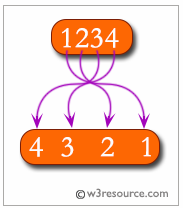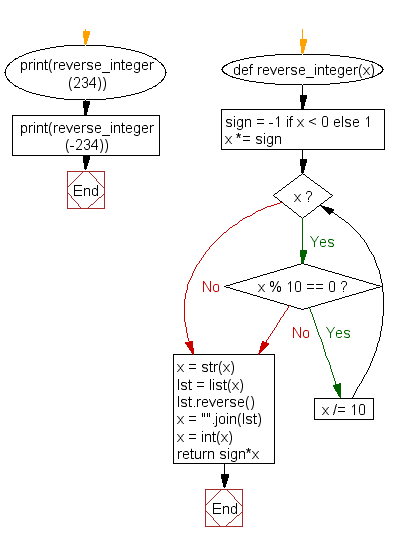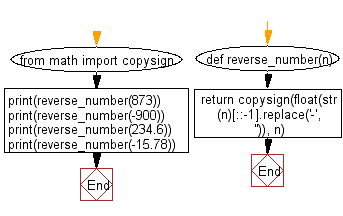Python Challenges: Reverse the digits of an integer
Python Challenges - 1: Exercise-18 with Solution
Write a Python program to reverse the digits of an integer.
Explanation:

Sample Example:
Input : 234
Input : -234
Output: 432
Output : -432
Sample Solution-1:
Python Code:
def reverse_integer(x):
sign = -1 if x < 0 else 1
x *= sign
# Remove leading zero in the reversed integer
while x:
if x % 10 == 0:
x /= 10
else:
break
# string manipulation
x = str(x)
lst = list(x) # list('234') returns ['2', '3', '4']
lst.reverse()
x = "".join(lst)
x = int(x)
return sign*x
print(reverse_integer(234))
print(reverse_integer(-234))
Sample Output:
432 -432
Flowchart:

Visualize Python code execution:
The following tool visualize what the computer is doing step-by-step as it executes the said program:
Sample Solution-2:
Reverses a number:
- Use str() to convert the number to a string, slice notation to reverse it and str.replace() to remove the sign.
- Use float() to convert the result to a number and math.copysign() to copy the original sign.
Python Code:
from math import copysign
def reverse_number(n):
return copysign(float(str(n)[::-1].replace('-', '')), n)
print(reverse_number(873))
print(reverse_number(-900))
print(reverse_number(234.6))
print(reverse_number(-15.78))
Sample Output:
378.0 -9.0 6.432 -87.51
Flowchart:

Visualize Python code execution:
The following tool visualize what the computer is doing step-by-step as it executes the said program:
Python Code Editor:
Contribute your code and comments through Disqus.
Previous: Write a Python program to find whether it contains an additive sequence or not.
Next: Write a Python program to reverse the bits of an integer (32 bits unsigned).
What is the difficulty level of this exercise?
Test your Programming skills with w3resource's quiz.
Python: Tips of the Day
Find current directory and file's directory:
To get the full path to the directory a Python file is contained in, write this in that file:
import os dir_path = os.path.dirname(os.path.realpath(__file__))
(Note that the incantation above won't work if you've already used os.chdir() to change your current working directory, since the value of the __file__ constant is relative to the current working directory and is not changed by an os.chdir() call.)
To get the current working directory use
import os cwd = os.getcwd()
Documentation references for the modules, constants and functions used above:
- The os and os.path modules.
- The __file__ constant
- os.path.realpath(path) (returns "the canonical path of the specified filename, eliminating any symbolic links encountered in the path")
- os.path.dirname(path) (returns "the directory name of pathname path")
- os.getcwd() (returns "a string representing the current working directory")
- os.chdir(path) ("change the current working directory to path")
Ref: https://bit.ly/3fy0R6m
- New Content published on w3resource:
- HTML-CSS Practical: Exercises, Practice, Solution
- Java Regular Expression: Exercises, Practice, Solution
- Scala Programming Exercises, Practice, Solution
- Python Itertools exercises
- Python Numpy exercises
- Python GeoPy Package exercises
- Python Pandas exercises
- Python nltk exercises
- Python BeautifulSoup exercises
- Form Template
- Composer - PHP Package Manager
- PHPUnit - PHP Testing
- Laravel - PHP Framework
- Angular - JavaScript Framework
- Vue - JavaScript Framework
- Jest - JavaScript Testing Framework
